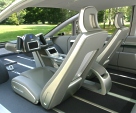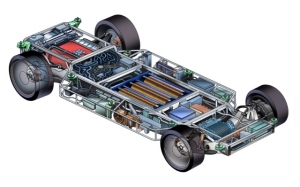
.
. .
..
. . .
Hummer Cars GM Concepts 2003 GM Concepts 2002 GM Concepts 2001
© 1998 - 2004
Copyright &
|
.
General Motors: Hy-wire Electronics
HY-WIRE'S ELECTRONIC CONTROLS CLEARED FOR TAKE-OFF
Developed by Swedish-based SKF, the by-wire technology enables all of Hy-wire's major driver-control functions, including steering, accelerator and brakes, to be consolidated into a flexible, hand-controlled unit called the X-drive. "In today's advanced aircraft, control commands are transmitted digitally from the cockpit through an electrical cable, or by wire, to the various parts of the plane. Hy-wire uses the same technology, allowing the driver to easily control the vehicle with either the right or left hand from the X-drive unit," said Mohsen Shabana, chief engineer for the Hy-wire program. "Drivers also have the option of driving from the left or right driving position because the X-drive is located in a center console that shuttles from left to right." Because it uses fully electronic connections and controls, the by-wire system simply plugs into the docking connections on the Hy-wire chassis. "At the heart of the by-wire system are smart electro-mechanical actuating units, which convert the driver's commands from electronic signals to motion," said Tom Johnstone, president of SKF's Automotive division. "The by-wire system also provides dynamic feedback to the driver via electronic signals." The advantages of by-wire technology in automobile applications include the elimination of steering columns and foot pedals, and allows greater design freedom, simplified production of left and right-hand drive models, and improved passive safety for the driver. The elimination of mechanical and hydraulic linkages saves weight and simplifies maintenance because there are fewer moving parts that can wear out. By-wire is more environmentally friendly because hydraulic fluids required for steering and braking are eliminated. Software allows the driver to personalize the handling characteristics of the vehicle by adjusting the feel of steering, braking and acceleration. Adjusting them is as simple as loading a new program. The Hy-wire's X-Drive replaces the usual round steering wheel and pedals, giving drivers the option to brake and accelerate with either the right or left hand. The driver accelerates by gently twisting either the right or left handgrip, and brakes by squeezing the handgrips. The handgrips glide up and down for steering, somewhat different than today's vehicles where the steering wheel revolves around a steering column. The X-Drive also incorporates an electronic monitor for rear-view and vital car functions, and shuttles easily from side-to-side on a horizontal bar that stretches across the full width of the vehicle. The steering system highlights the basic functions of the by-wire controls. A conventional vehicle uses a direct mechanical or hydraulic connection between the driver's control device and the relevant component. For instance, the commonly used rack-and-pinion steering system uses a small toothed wheel (the pinion) to engage the rack and to shift it left or right. Tie rods then carry the motion to the steering arms at the wheel. By-wire technology, in contrast, translates the driver's commands into electrical impulses. If the driver turns the handgrips of the X-Drive, sensors capture this motion digitally and send a signal to an electrical motor that moves the steering rack as instructed. Acceleration is similar to the throttle on a motorcycle, except that a throttle cable does not mechanically activate the throttle valve of the power plant. The by-wire system transmits an electronic signal to the control element of the 60-kilowatt electric motor that drives the Hy-wire's front wheels. "The driver operates the brakes very intuitively by automatically tightening the hand grips in a braking situation," said Filippo Zingariello, vice president of SKF's By-Wire Business Unit. Squeezing either the left or right hand grip slows the vehicle by way of grip sensors that determine how much hand pressure the driver exerts and transmits a signal that applies the brakes. The system, developed together with the Italian specialist, Brembo, works with conventional brake calipers, but responds faster. Maximum reliability and safety are essential features of the data-transmission system in by-wire control. "All safety systems have built-in redundancy and a back-up power supply similar to those used in fly-by-wire systems," Zingariello said. "This by-wire system uses proven technologies."
|
. |





















